MRDucks2
Member
Novice Liquid Diamonds vs Alumilite Clear
First experiment was the first attempt using Liquid Diamonds here:
http://www.penturners.org/forum/f43/novice-trial-liquid-diamonds-156315/
This time we wanted to try Liquid Diamonds side by side with Alumilite Clear so the compassion was pretty even. From the first review, our Liquid Diamonds stayed more pliable than we liked.
For this trial, I paid extra attention to making sure we were getting the 2:1 ratio for Liquid Diamonds as exact as I could to ensure no errors.
Here you see the Liquid Diamonds mixed in the cup:
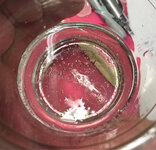
Compared to the Alumilite Clear:
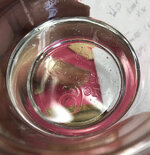
Basically I stirred as normal and ended up with about the same amount of bubbles in each.
Into the mold which had the left side coated with Stoner Mold Release and the right side coated with non-stick cooling spray (PAM in this case). See the mold release comparison here:
http://www.penturners.org/forum/f43/novice-trial-liquid-diamonds-156315/
Notice in the mold I took one of each product and embedded 3 pieces in them. 1 piece of stabilized dyed worthless wood, 1 piece of the Liquid Diamonds broken heart from the first pour and piece of orange dyed Alumilite Clear from my bucket of stuff I can't seem to throw away.
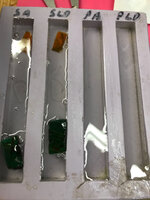
Into the big pot at 60psi for about 22 hours. I know the Alumilite didn't need this but have read the LD needed anywhere from 12-24 hours under pressure (or no pressure).
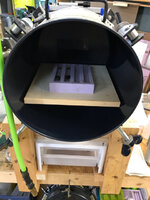
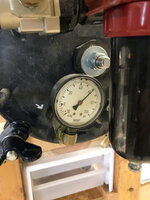
Out of the pot and both looked pretty good. The wood piece initially floated higher in the Alumilite than the LD (I presume due to the greater thickness of the Alumilite) but under pressure and cure the seemed to settle to the same level.
Clarity of the Clear resin really seemed about equal:
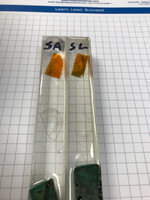
One thing to notice from a potential artistic perspective is that the Half a Heart made of Liquid Diamonds cast earlier in the week nearly disappeared in the LD blank. Wonder what a colored piece would have looked like.
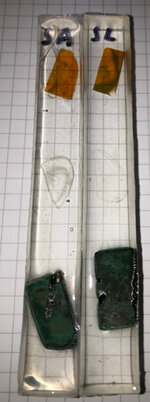
Now comes the odd stuff. By the time we finished this comparison we have become concerned that Chuck (dalecamino) received a bad batch of Liquid Diamonds from the vendor. Other experienced LD users also had issues with batches of the epoxy purchased around the same time.
Here I set a 2.5 lb weight on the Alumilite blank:
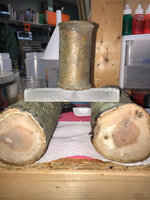
And the Liquid Diamonds blank:
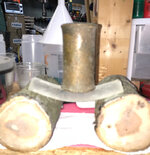
Obviously, mixed per directions 2:1 by weight, the LD is still very pliable.
Over a 4 day period it has firmed up some, but still more flexible than others have reported.
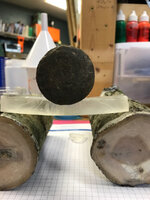
Other things learned:
Freezing the blanks had no effect on the Alumilite. It slowed the rate of cure slightly on the LD with it getting hard from freezing but being more pliable after thawing than an unfrozen LD blank.
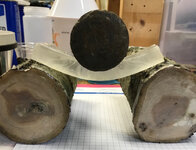 frozen then thawed day 2
frozen then thawed day 2
Heating the blanks to +/-150F had no real effect on either Liquid Diamonds or the Alumilite Blank.
Both the Liquid Diamonds and the Alumilite have the same fill/gram. 90 grams of each filled 2 blank molds to the same level. As such, you can directly compare cost/gram or ounce of product.
Though in this state (seeming to be pliable after cure) our Liquid Diamonds still had the previously mentioned toughness and self healing properties.
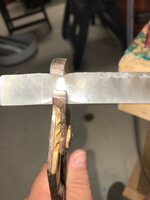
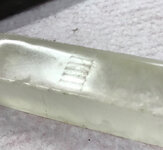
The Alumilite did not need the ability to heal as it was virtually unaffected by the channel locks.
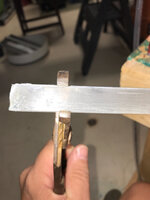
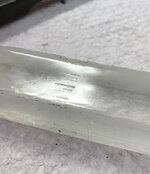
Neither blank was damaged by dropping on a painted concrete floor. Due to the softness of the cited blank, the LD cut about 2-3x deeper with the same pressure from a pocket knife as the Alumilite did.
Both products handled embedded items well. Without pressure, Liquid Diamonds will allow bubbles to settle out but trapped air pockets will remain trapped.
Alumilite Clear, with no pressure, will keep every bubble in it then some.
Due to the lower pour thickness or viscosity, it makes sense that Liquid Diamonds could better embed complex shapes.
However, for these tests, the Liquid Diamonds that Chuck purchased never seemed to fully cure. Info from others indicates it could be very sensitive to small changes in the mix ratio, using more hardener to improve its characteristics.
As such, Chuck has approved my use of the rest of his Liquid Diamonds from this evidently bad batch in a third trial using different mix ratios. Look for those results later this month.
The Alumilite Clear? Well, I measured it "close enough", it's a little old and clumpy in the part B and, as long as you mix it thoroughly, still comes out the same way each time. BUT, it needs pressure.
I may try Liquid Diamonds in the future as people I trust use it and say it is good. For this trial, I feel Chuck didn't get his money's worth with the Liquid Diamonds as it basically failed.
We'll see how the different hardener ratios do for the LD. They are in the pot.
Sent from my iPhone using Penturners.org mobile app
First experiment was the first attempt using Liquid Diamonds here:
http://www.penturners.org/forum/f43/novice-trial-liquid-diamonds-156315/
This time we wanted to try Liquid Diamonds side by side with Alumilite Clear so the compassion was pretty even. From the first review, our Liquid Diamonds stayed more pliable than we liked.
For this trial, I paid extra attention to making sure we were getting the 2:1 ratio for Liquid Diamonds as exact as I could to ensure no errors.
Here you see the Liquid Diamonds mixed in the cup:

Compared to the Alumilite Clear:

Basically I stirred as normal and ended up with about the same amount of bubbles in each.
Into the mold which had the left side coated with Stoner Mold Release and the right side coated with non-stick cooling spray (PAM in this case). See the mold release comparison here:
http://www.penturners.org/forum/f43/novice-trial-liquid-diamonds-156315/
Notice in the mold I took one of each product and embedded 3 pieces in them. 1 piece of stabilized dyed worthless wood, 1 piece of the Liquid Diamonds broken heart from the first pour and piece of orange dyed Alumilite Clear from my bucket of stuff I can't seem to throw away.

Into the big pot at 60psi for about 22 hours. I know the Alumilite didn't need this but have read the LD needed anywhere from 12-24 hours under pressure (or no pressure).


Out of the pot and both looked pretty good. The wood piece initially floated higher in the Alumilite than the LD (I presume due to the greater thickness of the Alumilite) but under pressure and cure the seemed to settle to the same level.
Clarity of the Clear resin really seemed about equal:

One thing to notice from a potential artistic perspective is that the Half a Heart made of Liquid Diamonds cast earlier in the week nearly disappeared in the LD blank. Wonder what a colored piece would have looked like.

Now comes the odd stuff. By the time we finished this comparison we have become concerned that Chuck (dalecamino) received a bad batch of Liquid Diamonds from the vendor. Other experienced LD users also had issues with batches of the epoxy purchased around the same time.
Here I set a 2.5 lb weight on the Alumilite blank:

And the Liquid Diamonds blank:

Obviously, mixed per directions 2:1 by weight, the LD is still very pliable.
Over a 4 day period it has firmed up some, but still more flexible than others have reported.

Other things learned:
Freezing the blanks had no effect on the Alumilite. It slowed the rate of cure slightly on the LD with it getting hard from freezing but being more pliable after thawing than an unfrozen LD blank.
 frozen then thawed day 2
frozen then thawed day 2Heating the blanks to +/-150F had no real effect on either Liquid Diamonds or the Alumilite Blank.
Both the Liquid Diamonds and the Alumilite have the same fill/gram. 90 grams of each filled 2 blank molds to the same level. As such, you can directly compare cost/gram or ounce of product.
Though in this state (seeming to be pliable after cure) our Liquid Diamonds still had the previously mentioned toughness and self healing properties.


The Alumilite did not need the ability to heal as it was virtually unaffected by the channel locks.


Neither blank was damaged by dropping on a painted concrete floor. Due to the softness of the cited blank, the LD cut about 2-3x deeper with the same pressure from a pocket knife as the Alumilite did.
Both products handled embedded items well. Without pressure, Liquid Diamonds will allow bubbles to settle out but trapped air pockets will remain trapped.
Alumilite Clear, with no pressure, will keep every bubble in it then some.
Due to the lower pour thickness or viscosity, it makes sense that Liquid Diamonds could better embed complex shapes.
However, for these tests, the Liquid Diamonds that Chuck purchased never seemed to fully cure. Info from others indicates it could be very sensitive to small changes in the mix ratio, using more hardener to improve its characteristics.
As such, Chuck has approved my use of the rest of his Liquid Diamonds from this evidently bad batch in a third trial using different mix ratios. Look for those results later this month.
The Alumilite Clear? Well, I measured it "close enough", it's a little old and clumpy in the part B and, as long as you mix it thoroughly, still comes out the same way each time. BUT, it needs pressure.
I may try Liquid Diamonds in the future as people I trust use it and say it is good. For this trial, I feel Chuck didn't get his money's worth with the Liquid Diamonds as it basically failed.
We'll see how the different hardener ratios do for the LD. They are in the pot.
Sent from my iPhone using Penturners.org mobile app
